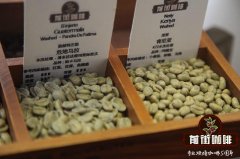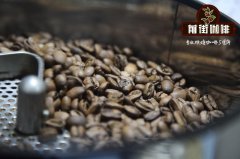Analysis of Coffee varieties and Variety characteristics where should Yunnan Katim coffee beans be planted?

Professional coffee knowledge exchange more coffee bean information please follow the coffee workshop (Wechat official account cafe_style)
1. Varieties and characteristics of coffee:
Coffee tree is a shrub. Botanically, it belongs to Rubiaceae family (Rubiaceae) of the genus Coffea. It has more than 6000 species and more than 500 genera. Although 25 to 100 of them have been questioned whether they should be included in the Coffea. Most of the raw beans with economic value belong to C. arabica or C. canephora species, called Arabica Arabica (coffea arabica) and Robusta Robusta (coffea canephora), respectively. Coffea arabica is the result of inbreeding of allotetraploid (2n = 44). There are 40 to 50 known varieties (infraspecific taxa), which are suspected to be from var. Arabica (including var. C. arabica and var in typica. The two varieties of bourbon. In addition to these two varieties, there are Leibirika coffee Liberica and Issa coffee Excelsa.
In terms of economic value, the main varieties of coffee in circulation are Arabica and Robusta. Arabica coffee accounts for about 70% of the market, and Robusta accounts for about 30%.
There are two main varieties of Arabica, namely Kaddura Caturra and Cartier Catimor. Cartimo is currently the most widely grown coffee variety in the world, accounting for about 75% of the Arabica varieties. Cartimo Catimor is a hybrid of Caturra and Timor Timor, which has 25% Robusta gene. The advantages are strong disease resistance, drought tolerance and high yield.
Botanical classification of various coffee varieties
Coffea arabica L.
Arabian coffee
Arabica coffee
(Arabica coffee) Coffea canephora Pierre ex Froehner
Robusta coffee
Robusta coffee Coffea liberica Bull ex Hiern.
Liberian coffee
Liberian coffee
Family
Section
Rubiaceae-Madder family alizarin
Rubiaceae-Madder family
Rubia officinalis Rubiaceae-Madder family
Rubia officinalis L.
Genus
Coffea L.-coffee
Coffee Coffea L.-coffee
Coffee Coffea L.-coffee
Coffee
Species species
Coffea arabica L.-
Arabian coffee
Coffea canephora Pierre ex Froehner-robusta coffee
Coffea liberica Bull ex Hiern. -Liberian coffee
two。 The varieties of coffee for production in the world and their basic characteristics:
1). Typica Tabica
This is the foundation of many coffee varieties that have been born. Other propagated Arabica species come from this variety. The plants of Typica have a circular vertebra-shaped profile and are slightly inclined by the trunk and lateral branches. The plant is 3.5-4 meters high. An angle of 50-70 degrees is formed between the lateral branch and the trunk. The output of Typica is small, but the quality of brewing is excellent.
2). Bourbon side wave
The yield is 20-30% higher than that of Typica, but less than that of most varieties. The shape of the round vertebra is smaller than that of Typica, but there are more lateral branches. The angle between the lateral branch and the trunk is relatively small, and the connecting point of the lateral branch on the trunk is very close. Leaf blade broad, leaf margin wavy. The fruit is small and thick. The fruit ripens quickly, but there is a risk of falling fruit due to strong winds and heavy rains. The most suitable height for planting is between 1000 and 2000 meters. The brewing quality is as superior as that of Typica.
3). Caturra Kaddura
Is a mutant of Bourbon found in Brazil. If careful care and adequate fertilizer are given, there will be mutants with high yield and high quality. The tree is short and dense with many lateral branches. The leaf shape is large, and there are wavy Bourbon species on the leaf edge. It is suitable for growing in any environment, but it is best at an altitude of 450m-1700 m and an annual rainfall of 2500-3500 tons. The higher the altitude, the better the quality, but the yield is relatively lower.
4). Catuai Kaduai
It is a high yield variety crossed by Mundo novo and Caturra. The plant is relatively short, and the angle between the lateral branch and the main branch is small. The fruit is not easy to fall off from the branches, so it is suitable for planting in areas with strong wind and heavy rainfall. Catuai also needs a lot of fertilizer and needs to be taken care of.
5). Pache comum
It is a variant of Typica, which first appeared in El Brito, Santa Cruz Naranjo and Santa Rosa in Guatemala. The quality of brewing is very smooth. The most suitable for planting is between 1000 and 1700 meters.
6). Pache colis
It was found on a farm in Mataquescuintla, Guatemala, and is a hybrid of Caturra and Pache comum. The fruit is large and the leaves are rough. Pache colis has anti-phoma effect. The branch has the second lateral branch and the third lateral branch, and the height is between 0.8 and 1.25m. It is suitable for planting at an altitude of 9-1800 meters and a temperature of 20-21 ℃. It matures relatively early, has a high output, and its production capacity is much higher than that of other varieties with commercial interests. Therefore, more attention should be paid to fertilization and shading management.
7). Catimor Katim
It was hybridized with rust-resistant Timor and Caturra in Portugal in 1959. It has early maturity and strong disease resistance, and its yield is much higher than that of other varieties with commercial value. For this reason, we must be diligent in fertilization and pay attention to shading. The offspring of Catimor TMel 8667 are relatively short, but their fruits and seeds are very large. Catimor line TMel 5269 is very strong and suitable for growing in areas with an altitude of 600m-900m and annual rainfall of more than 3000 centimeters. The Tmur5175 is highly productive and robust, but it can be troublesome at too high or too low altitudes. At low elevations, its quality is similar to that of other varieties of commercial value, but above 1200 meters, its quality is much better than Bourbon, Caturra and Cauai.
From 26 to 28 February 2001, the Royal Planning Foundation of Thailand and the United Nations Food and Agriculture Organization jointly organized an event entitled "The First Asian Regional Round-Table on Sustainable, Organic and Speciality Coffee Production, Processing and Marketing" in Chiang Mai (the first Round Table on Sustainable, Organic and refined Coffee production, processing and Marketing in Asia). During the meeting, Dr. Ernesto Illy, the boss of the Italian Illy Coffee Company, mentioned the poor quality of Katim coffee in his speech "the negative factors in the quality of coffee raw beans." Because it has 25% robusta coffee gene, although it enhances the ability to resist rust, its quality is reduced by its influence.
8). Kent Kent
It has the characteristics of high yield and rust resistance.
9). Mundo Novo Mondonover
The natural hybrid of Typica and Bourbon first appeared in Brazil. The plant is strong and resistant to disease. It has high yield, but matures more slowly than other varieties. It is suitable for planting in areas with an altitude of 1000-1500 meters and an annual rainfall of 1200-1800 tons.
10). Maragogype
Typica mutant found in Brazil. The plant of Maragogype is larger than that of Bourbon and Typica. The yield is low, but the bean shape is very large. Maragogype is suitable for planting between 750 and 1500 feet above sea level. The quality characteristics are suitable for some specific markets.
11). Blue mountain Blue Mountain
It is famous for its resistance to coffee fruit blight and its exuberant growth at high altitudes. It is grown in Jamaica and now in the Kona area of Hawaii. This variety does not show its high-quality aroma in all climatic conditions.
3. Introduction to different varieties of coffee (source: J.H.M. Op de Laak, 1992)
Catimor coffee Katimo Coffee Tree
Caturra coffee Kaddura Coffee Tree
Congensis coffee Congins Coffee Tree
Excelsa coffee Issa Coffee Tree
Liberica coffee Rabirika Coffee Tree or Liberian Coffee.
Robusta coffee Robusta Coffee Tree
Typica coffee Tibica Coffee Tree
Important Notice :
前街咖啡 FrontStreet Coffee has moved to new addredd:
FrontStreet Coffee Address: 315,Donghua East Road,GuangZhou
Tel:020 38364473
- Prev

Vietnam Coffee Bean planting situation, Flavor and Taste performance introduce how to choose and how to buy Vietnamese coffee beans?
Professional coffee knowledge exchange more coffee bean information please follow the coffee workshop (Wechat official account cafe_style) said that the coffee producing area, Vietnam does not seem to have a cup test of the world's top few beans, but in terms of world coffee output, Vietnam has always been in the top several, not only in recent years, but also rose to become the world's largest coffee exporter in 2012, for the first time
- Next

The relationship between the new coffee variety Castillo and Catimor is worse than Katim's Robusta.
Professional coffee knowledge exchange more coffee bean information please follow the coffee workshop (Wechat official account cafe_style) this morning Elixr saw a Colombian coffee variety is unseen Castillo of course, of course, try to drink it, it seems to be good to wait until half a cup, feel the heartbeat and tremble slightly feel wrong quickly look up the information on the Internet.
Related
- Detailed explanation of Jadeite planting Land in Panamanian Jadeite Manor introduction to the grading system of Jadeite competitive bidding, Red bid, Green bid and Rose Summer
- Story of Coffee planting in Brenka region of Costa Rica Stonehenge Manor anaerobic heavy honey treatment of flavor mouth
- What's on the barrel of Blue Mountain Coffee beans?
- Can American coffee also pull flowers? How to use hot American style to pull out a good-looking pattern?
- Can you make a cold extract with coffee beans? What is the right proportion for cold-extracted coffee formula?
- Indonesian PWN Gold Mandrine Coffee Origin Features Flavor How to Chong? Mandolin coffee is American.
- A brief introduction to the flavor characteristics of Brazilian yellow bourbon coffee beans
- What is the effect of different water quality on the flavor of cold-extracted coffee? What kind of water is best for brewing coffee?
- Why do you think of Rose Summer whenever you mention Panamanian coffee?
- Introduction to the characteristics of authentic blue mountain coffee bean producing areas? What is the CIB Coffee Authority in Jamaica?

